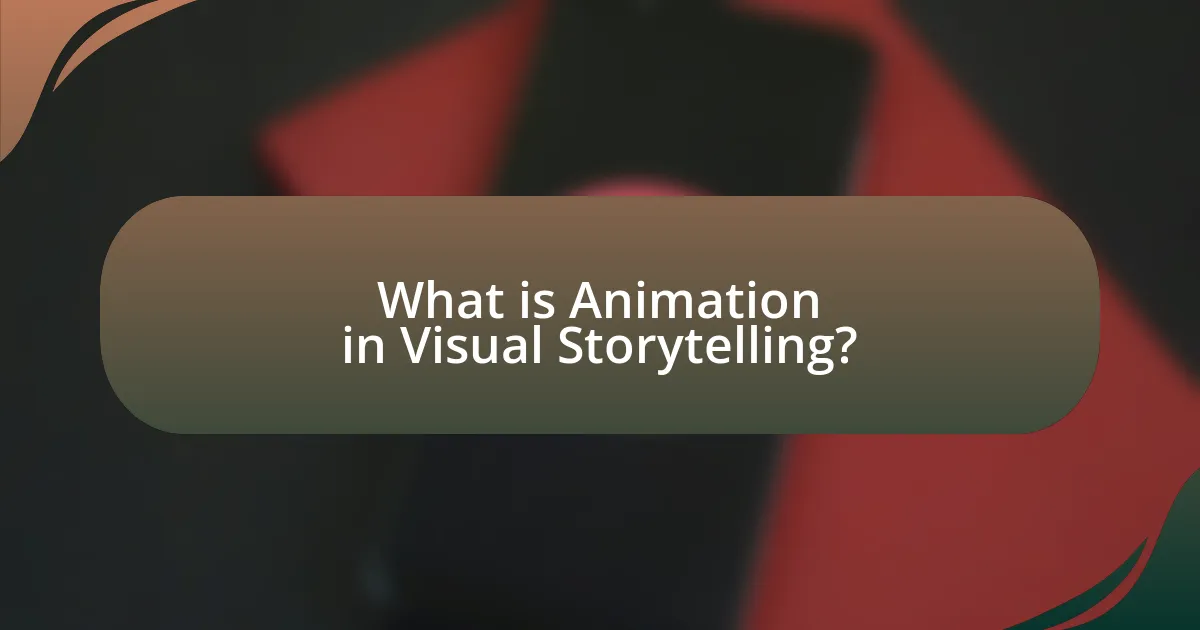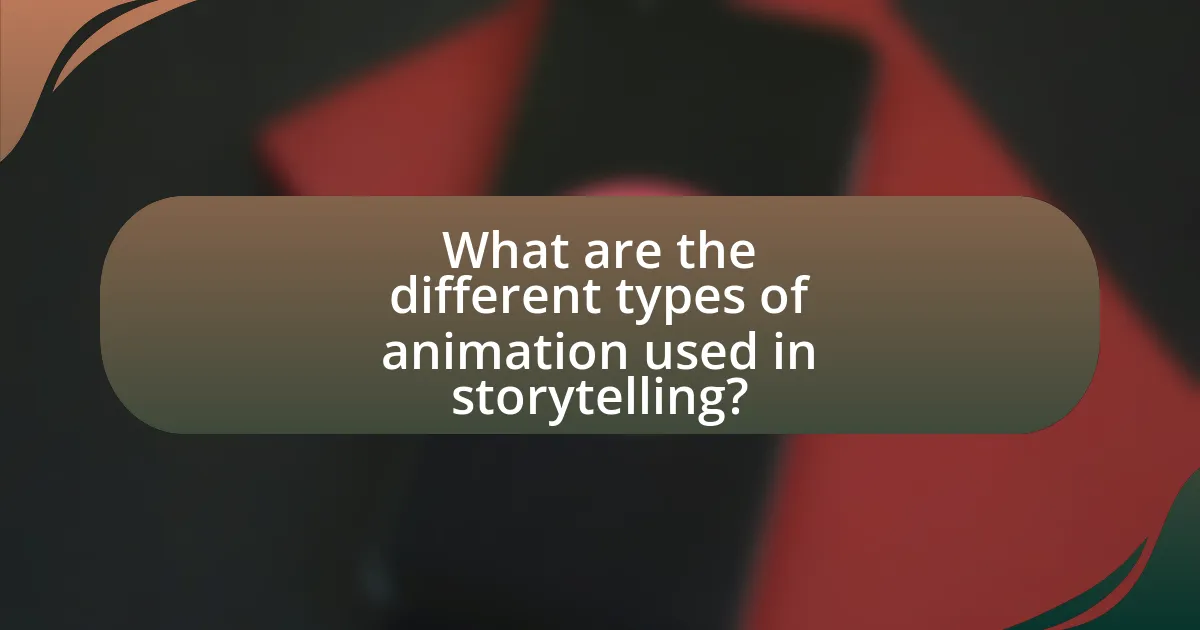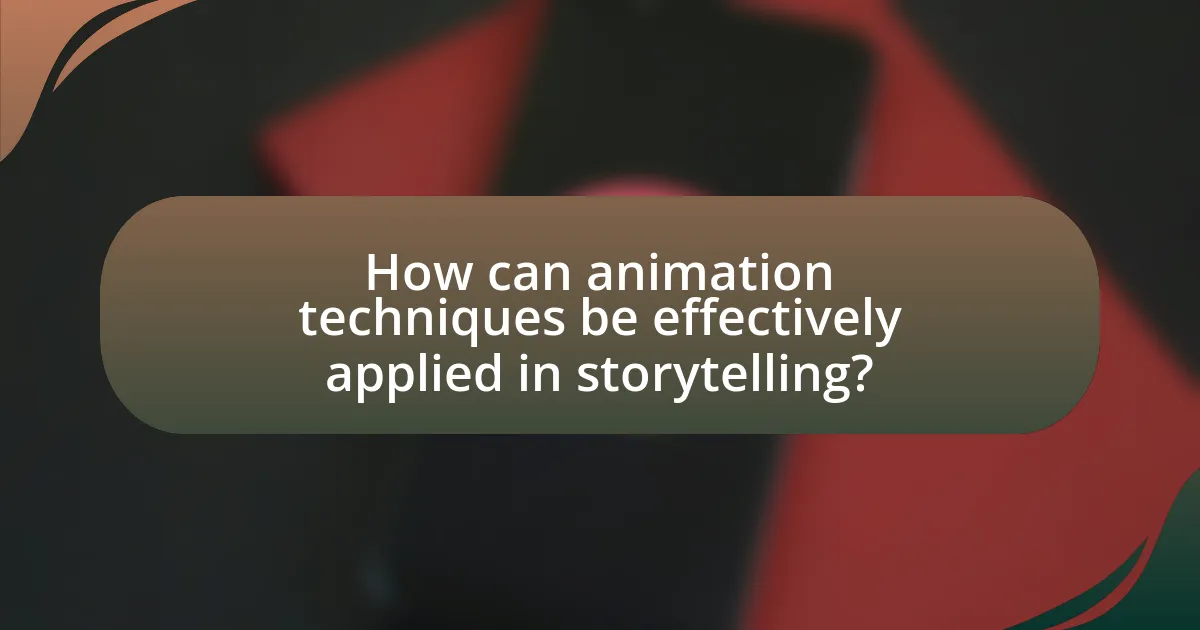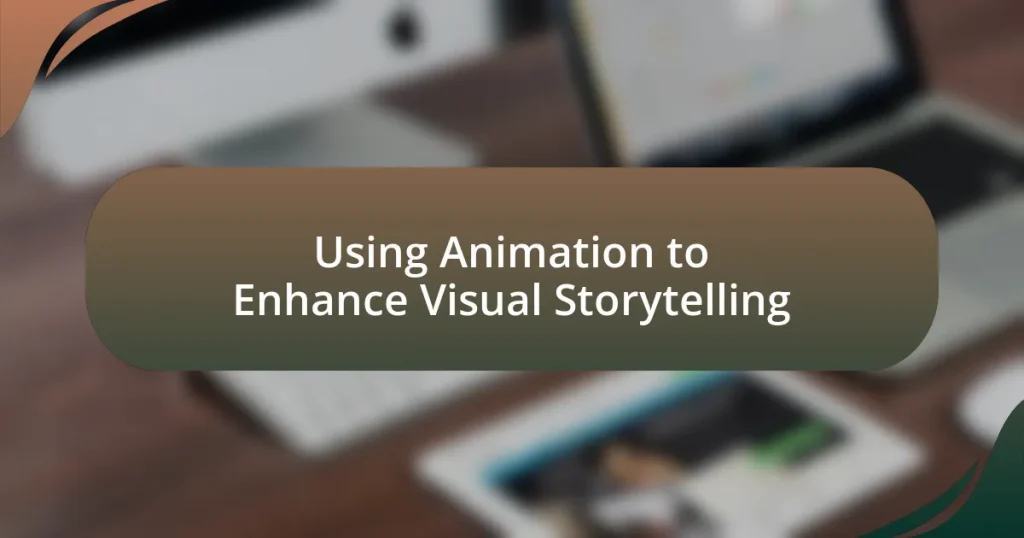Animation is a powerful technique in visual storytelling that creates moving images to convey narratives and emotions, enhancing audience engagement through dynamic elements. This article explores how animation improves storytelling techniques by utilizing character design, movement, timing, and visual style to express complex ideas and emotions. It discusses various types of animation, including traditional, 2D, 3D, and stop-motion, and their impact on narrative delivery. Additionally, the article highlights best practices for integrating animation into narratives, common pitfalls to avoid, and tips for creating compelling animated stories, emphasizing the medium’s ability to cater to diverse audiences and simplify complex concepts.

What is Animation in Visual Storytelling?
Animation in visual storytelling is the technique of creating moving images to convey narratives and emotions. This method enhances storytelling by adding dynamic elements that engage viewers, allowing for the expression of complex ideas and feelings that static images cannot achieve. For instance, animated films like “Toy Story” utilize character movement and visual effects to create emotional connections, demonstrating how animation can effectively communicate themes and character development.
How does animation enhance storytelling techniques?
Animation enhances storytelling techniques by providing a dynamic visual medium that can convey emotions, actions, and narratives in ways that traditional forms cannot. Through the use of color, movement, and exaggerated expressions, animation allows for the portrayal of complex themes and character development, engaging audiences on a deeper emotional level. For instance, animated films like “Inside Out” effectively illustrate abstract concepts such as emotions through personification, making them relatable and understandable. This ability to visualize intangible ideas supports storytelling by creating immersive experiences that resonate with viewers, thereby enhancing their connection to the narrative.
What are the key elements of animation that contribute to storytelling?
The key elements of animation that contribute to storytelling include character design, movement, timing, and visual style. Character design establishes the personality and relatability of animated figures, which is crucial for audience engagement. Movement conveys emotions and actions, allowing viewers to connect with the narrative; for instance, exaggerated movements can enhance comedic effects while subtle gestures can express deeper emotions. Timing is essential in animation, as it dictates the pacing of the story and influences the audience’s emotional response; precise timing can create tension or humor effectively. Visual style, including color palettes and artistic techniques, sets the tone and atmosphere of the story, guiding audience perception and emotional engagement. These elements work together to create a cohesive narrative experience, making animation a powerful medium for storytelling.
How does animation influence audience engagement in storytelling?
Animation significantly enhances audience engagement in storytelling by creating visually dynamic narratives that capture attention and evoke emotional responses. The use of vibrant colors, fluid movements, and imaginative characters in animation stimulates viewers’ senses, making the story more immersive. Research indicates that animated content can increase retention rates by up to 65% compared to static images, as demonstrated in studies by the University of California, which found that animated visuals help in better information processing and recall. This heightened engagement leads to a deeper connection with the narrative, as audiences are more likely to empathize with animated characters and invest emotionally in their journeys.
Why is animation a preferred medium for visual storytelling?
Animation is a preferred medium for visual storytelling because it allows for the creation of imaginative worlds and characters that can convey complex emotions and narratives in a visually engaging manner. This medium transcends the limitations of live-action by enabling the depiction of fantastical elements, such as talking animals or surreal landscapes, which can enhance the storytelling experience. For instance, animated films like “Toy Story” and “Spirited Away” have successfully utilized animation to explore themes of friendship and identity, respectively, resonating with audiences of all ages. Furthermore, animation can simplify complex ideas, making them accessible to a broader audience, as seen in educational animations that explain scientific concepts through visual metaphors.
What advantages does animation have over traditional storytelling methods?
Animation offers the advantage of visual dynamism, allowing for the portrayal of imaginative scenarios that traditional storytelling methods cannot easily achieve. This medium enables creators to depict fantastical elements, such as characters with exaggerated features or environments that defy the laws of physics, enhancing engagement and emotional impact. For instance, animated films like “Toy Story” and “Spirited Away” utilize vibrant visuals and imaginative storytelling to captivate audiences, demonstrating that animation can convey complex narratives and emotions effectively. Additionally, animation can simplify complex ideas through visual metaphors, making them more accessible to diverse audiences, including children and non-native speakers. This versatility in expression and accessibility underscores animation’s unique advantages over traditional storytelling methods.
How does animation cater to diverse audiences and demographics?
Animation caters to diverse audiences and demographics by employing various styles, themes, and cultural references that resonate with different groups. For instance, animated films like “Coco” celebrate Mexican culture, while “Mulan” reflects Chinese heritage, showcasing how animation can represent specific cultural narratives. Additionally, animation’s versatility allows it to address a wide range of topics, from children’s educational content to adult-oriented themes, thus appealing to various age groups and interests. According to a report by the Animation Guild, the global animation market was valued at approximately $270 billion in 2020, indicating its broad reach and popularity across different demographics. This adaptability in storytelling and visual representation enables animation to engage and connect with a wide audience effectively.

What are the different types of animation used in storytelling?
The different types of animation used in storytelling include traditional animation, 2D animation, 3D animation, stop-motion animation, and motion graphics. Traditional animation involves hand-drawn images that are sequenced to create movement, while 2D animation uses digital tools to create flat images that can be manipulated. 3D animation utilizes computer-generated imagery to create lifelike characters and environments, allowing for depth and realism. Stop-motion animation involves photographing physical objects in incremental movements to produce the illusion of motion. Motion graphics combine graphic design elements with animation techniques to convey information or tell a story visually. Each type serves distinct narrative purposes and enhances storytelling through visual engagement.
How do various animation styles impact narrative delivery?
Various animation styles significantly impact narrative delivery by influencing audience engagement and emotional resonance. For instance, traditional 2D animation often evokes nostalgia and can simplify complex narratives, making them more accessible, as seen in classic Disney films. In contrast, 3D animation provides a sense of realism and depth, enhancing immersive storytelling, which is evident in Pixar’s works that blend humor with emotional depth. Additionally, stop-motion animation creates a tactile quality that can evoke a unique emotional response, as demonstrated in films like “Coraline.” Each style shapes how viewers interpret characters and themes, ultimately affecting the overall effectiveness of the narrative.
What are the characteristics of 2D animation in storytelling?
2D animation in storytelling is characterized by its ability to convey emotions and narratives through visual simplicity and stylization. This form of animation utilizes flat images and limited depth, allowing for a focus on character expressions and movements that enhance emotional engagement. The use of vibrant colors and distinct art styles in 2D animation can evoke specific moods and themes, making it effective for storytelling. Additionally, 2D animation often employs exaggerated movements and visual metaphors, which can simplify complex ideas and make them more accessible to audiences. Historical examples, such as Disney’s early animated films, demonstrate how 2D animation can effectively communicate character arcs and plot developments through visual storytelling techniques.
How does 3D animation enhance visual depth in narratives?
3D animation enhances visual depth in narratives by creating a realistic spatial environment that allows viewers to perceive objects and characters in three dimensions. This dimensionality enables the portrayal of depth cues such as perspective, lighting, and shadow, which contribute to a more immersive storytelling experience. For instance, films like “Avatar” utilize advanced 3D techniques to provide a sense of scale and realism, making the viewer feel as if they are part of the world. Research indicates that audiences respond more positively to narratives presented in 3D due to the increased engagement and emotional connection fostered by this enhanced visual depth.
What role does stop-motion animation play in storytelling?
Stop-motion animation plays a crucial role in storytelling by providing a unique visual style that enhances narrative engagement. This technique allows creators to bring inanimate objects to life, creating a tangible connection between the audience and the characters. For instance, films like “The Nightmare Before Christmas” and “Coraline” utilize stop-motion to convey emotions and themes that resonate deeply with viewers, showcasing the medium’s ability to evoke empathy and imagination. The meticulous frame-by-frame process of stop-motion also allows for intricate details and artistic expression, further enriching the storytelling experience.
How does stop-motion create a unique narrative experience?
Stop-motion creates a unique narrative experience by allowing for meticulous control over movement and expression, which enhances storytelling depth. This animation technique involves capturing individual frames of physical objects or puppets, resulting in a tactile and visually distinct aesthetic that engages viewers differently than traditional animation or live-action. The deliberate pacing and frame-by-frame manipulation enable animators to convey emotions and actions with precision, creating a sense of realism and intimacy. For instance, films like “Coraline” and “The Nightmare Before Christmas” showcase how stop-motion can evoke specific moods and themes through its unique visual style, reinforcing the narrative in ways that resonate with audiences.
What are the challenges of using stop-motion in storytelling?
The challenges of using stop-motion in storytelling include time consumption, technical complexity, and limited flexibility. Stop-motion animation requires meticulous frame-by-frame shooting, which can take significantly longer than other animation techniques; for instance, creating just one minute of stop-motion footage can take several days or even weeks. Additionally, the technical aspects, such as lighting, camera stability, and puppet manipulation, demand a high level of skill and precision, making it difficult for beginners. Lastly, once a scene is shot, making changes can be cumbersome, as it often requires reshooting multiple frames, which limits the creative flexibility that other animation forms may offer.

How can animation techniques be effectively applied in storytelling?
Animation techniques can be effectively applied in storytelling by enhancing emotional engagement and visual clarity. Techniques such as character design, movement, and color palettes can evoke specific emotions, making the narrative more relatable. For instance, exaggerated facial expressions in animation can convey feelings more vividly than static images, allowing audiences to connect with characters on a deeper level. Additionally, the use of dynamic camera angles and transitions in animated sequences can guide viewer attention and emphasize key plot points, thereby improving narrative flow. Research indicates that animated storytelling can increase retention of information by up to 50%, demonstrating its effectiveness in engaging audiences and enhancing understanding.
What are the best practices for integrating animation into narratives?
The best practices for integrating animation into narratives include ensuring that the animation serves the story, enhancing emotional engagement, and maintaining a consistent visual style. Animation should complement the narrative by illustrating key themes or character emotions, as seen in films like “Up,” where animated sequences effectively convey the protagonist’s backstory and emotional depth. Additionally, using animation to highlight pivotal moments can create a stronger connection with the audience, as demonstrated in “Spider-Man: Into the Spider-Verse,” which utilizes unique animation styles to reflect character perspectives. Consistency in visual style is crucial; mismatched animation can distract viewers and detract from the narrative flow, as evidenced by successful animated series like “Avatar: The Last Airbender,” which maintains a cohesive aesthetic throughout its episodes.
How can storyboarding enhance the animation process?
Storyboarding enhances the animation process by providing a visual blueprint that outlines the sequence of events and actions in a narrative. This structured approach allows animators to visualize scenes, plan camera angles, and establish pacing before production begins. Research indicates that storyboarding can reduce production time by up to 30% by identifying potential issues early, allowing for adjustments in the narrative flow and character development. Additionally, it fosters collaboration among team members, ensuring that everyone shares a clear understanding of the story and visual style, which ultimately leads to a more cohesive final product.
What tools and software are essential for animators in storytelling?
Essential tools and software for animators in storytelling include Adobe Animate, Toon Boom Harmony, and Blender. Adobe Animate is widely used for creating interactive animations and offers a robust set of features for character animation and storytelling. Toon Boom Harmony is a professional-grade software favored for its advanced animation capabilities, including rigging and compositing, which enhance narrative depth. Blender, an open-source 3D software, provides powerful modeling, animation, and rendering tools, making it suitable for both 2D and 3D storytelling. These tools are integral to the animation process, enabling animators to effectively convey stories through visual media.
What common pitfalls should be avoided in animated storytelling?
Common pitfalls to avoid in animated storytelling include weak character development, lack of a coherent narrative structure, and over-reliance on visual effects. Weak character development can lead to audiences feeling disconnected from the story, as characters need depth and relatability to engage viewers. A lack of coherent narrative structure can result in confusion, making it difficult for the audience to follow the plot; a well-defined beginning, middle, and end is essential for clarity. Over-reliance on visual effects can detract from the story itself, as the animation should enhance the narrative rather than overshadow it. These pitfalls can undermine the effectiveness of animated storytelling, as evidenced by numerous critiques of animated films that fail to resonate with audiences due to these issues.
How can overuse of animation detract from the story?
Overuse of animation can detract from the story by overwhelming the narrative and distracting the audience from the core message. When animation is excessively flashy or frequent, it can shift focus away from character development and plot progression, leading to viewer disengagement. Research indicates that audiences may experience cognitive overload when presented with too many visual stimuli, which can hinder their ability to process the story effectively. For instance, a study published in the Journal of Educational Psychology found that excessive multimedia elements can impair learning and retention, suggesting that a balance is crucial for effective storytelling.
What are the signs of poor animation quality in storytelling?
Signs of poor animation quality in storytelling include inconsistent character movements, lack of fluidity in action sequences, and poorly synchronized audio. Inconsistent character movements can disrupt the viewer’s immersion, as characters may appear to float or jerk unnaturally, which detracts from the narrative. Lack of fluidity in action sequences often results in choppy transitions that fail to convey the intended emotion or tension, making scenes feel disjointed. Poorly synchronized audio, such as mismatched dialogue and character lip movements, can further alienate the audience, as it creates a disconnect between what is seen and heard. These elements collectively undermine the storytelling experience, making it difficult for viewers to engage with the narrative effectively.
What are some tips for creating compelling animated stories?
To create compelling animated stories, focus on strong character development, engaging plots, and visual aesthetics. Strong character development ensures that audiences connect emotionally with the characters, making them more invested in the story. Engaging plots should have clear conflicts and resolutions, which maintain viewer interest and drive the narrative forward. Visual aesthetics, including color schemes and animation styles, enhance storytelling by setting the tone and mood, as evidenced by successful animated films like “Toy Story” and “Spirited Away,” which utilize these elements effectively to captivate audiences.
